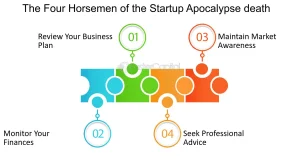IT Project Failures: The 4 Horsemen of the Apocalypse


In the realm of Information Technology (IT), projects often hold the promise of innovation, efficiency, and transformation. However, they can also be plagued by a set of recurring challenges that, like the legendary Four Horsemen of the Apocalypse, can bring about disaster and chaos. These relentless adversaries of IT project success have earned their ominous reputation through a trail of failed initiatives, missed deadlines, and budget overruns.
In this exploration of the “4 Horsemen of IT Project Failures,” we delve into the common afflictions that have time and again threatened the success of even the most well-intentioned IT endeavors. Unveiling these malevolent forces is crucial, as understanding their nature is the first step towards developing strategies to prevent their disastrous impact. From inadequate planning and scope creep to poor communication and changing requirements, we’ll examine the characteristics of these project-derailing adversaries and, most importantly, 4 horsemans ,how to shield your IT projects from their destructive influence.
Join us on this journey through the turbulent landscape of IT project management as we confront the “4 Horsemen of IT Project Failures” and uncover the strategies to ensure your projects ride to victory instead of being led to ruin.
IT Project Failures: The Consequences of Poor Planning
In the dynamic world of Information Technology (IT), project failures can be incredibly costly, both in terms of time and resources. One of the most common reasons behind these failures is poor planning. When IT projects are launched without comprehensive, well-thought-out plans, 4 horsemans they are at a significantly higher risk of stumbling along the way. This article explores the far-reaching consequences of poor planning in IT projects and offers insights on how to avoid these pitfalls.


The Impact of Poor Planning:
Budget Overruns:
- Poor planning often results in budget overruns. Without a detailed budget, it becomes challenging to accurately estimate the costs associated with the project.4 horsemans Unexpected expenses can accumulate, putting a strain on resources and potentially jeopardizing the project’s completion.
Missed Deadlines:
- Inadequate planning can lead to missed project deadlines. Without a clear timeline, milestones, and task assignments, team members may lack the guidance needed to stay on track. Delays can disrupt the project’s schedule and undermine its success.
Scope Creep:
- Poorly defined project scopes can give rise to scope creep. When the project’s objectives and requirements are not clearly outlined, stakeholders may introduce changes and additions that were not part of the original plan. This can complicate the project and increase the risk of failure.
Ineffective Resource Allocation:
- Without proper planning, it’s challenging to allocate resources effectively. This can lead to overutilization of certain resources and underutilization of others, 4 horsemans ,resulting in inefficient project execution.
Reduced Quality:
- Inadequate planning may force teams to cut corners or rush through critical phases of the project. This can compromise the quality of the final product, potentially leading to costly fixes and diminishing the project’s overall success.
Poor Risk Management:
- A robust project plan includes risk assessments and mitigation strategies. Poorly planned projects often lack comprehensive risk management, making them vulnerable to unforeseen issues that can derail progress.
Team Disengagement:
- Team members can become disengaged when they sense a lack of direction or commitment to a project due to poor planning. This can lead to decreased morale, productivity, and overall team cohesion.
Stakeholder Dissatisfaction:
- When stakeholders, including clients and end-users, are not involved in the planning process or when their expectations are not properly managed, dissatisfaction can arise. This can lead to strained relationships and reputational damage.
How to Avoid Poor Planning:
Comprehensive Requirements Gathering:
- Ensure thorough gathering and documentation of project requirements to establish a clear project scope.
Detailed Project Plan:
- Develop a comprehensive project plan that outlines objectives, timelines, task assignments, and resource allocation.
Risk Assessment and Mitigation:
- Identify potential risks and develop strategies for mitigating them throughout the project.
Stakeholder Engagement:
- Involve all relevant stakeholders in the planning process and set clear expectations.
Regular Monitoring and Adjustments:
- Continuously monitor the project’s progress and be prepared to make adjustments as needed to keep it on track.
Conclusion:
Poor planning is a significant contributor to IT project failures, and the consequences can be extensive. By investing time and effort into detailed and thoughtful planning, organizations can significantly improve the chances of project success and avoid the costly setbacks associated with inadequate preparation.
Wrong technical approach


IT project failures due to the wrong technical approach can be a costly and frustrating experience for organizations.
Here’s a description of this issue:
In the ever-evolving landscape of information technology, project failures are often rooted in one critical misstep: the wrong technical approach. These failures not only result in financial losses but also disrupt operations, damage reputation, and erode trust. Understanding the profound impact of choosing the incorrect technical path is the first step in avoiding such pitfalls.
The wrong technical approach can manifest in various ways:
- Mismatched Technology Stack: Selecting the wrong technology stack, programming language, or framework for a project can lead to compatibility issues, reduced performance, and difficulties in scaling. This misalignment can result in inefficiencies and increased project costs.
- Lack of Scalability: Failure to plan for future growth and scalability can cripple a project in the long run. A technical approach that doesn’t accommodate expanding user bases or increased data volume can quickly become obsolete.
- Ignoring Industry Best Practices: Neglecting industry best practices and standards can lead to poor security, data breaches, and regulatory non-compliance. A wrong technical approach that disregards these crucial factors can lead to dire consequences.
-
Inadequate Testing:
- Skipping or inadequately performing testing procedures can result in undetected technical issues, leading to project failures once deployed. It’s crucial to adopt a comprehensive testing strategy.
- Over-Engineering: An overly complex technical approach can lead to higher development costs, increased maintenance efforts, and longer time-to-market. Finding the right balance between innovation and practicality is essential.
- Underestimating Technical Complexity: Underestimating the technical complexities of a project can lead to missed deadlines and budget overruns. It’s vital to have a clear understanding of the project’s technical requirements from the outset.
- Neglecting User Experience: Focusing solely on technical aspects without considering the end-user experience can result in projects that fail to meet the needs and expectations of their intended audience.
Avoiding IT project failures due to the wrong technical approach demands careful planning, expert consultation, and a commitment to staying updated with industry trends. It’s imperative for organizations to invest time and resources in ensuring their technical approach aligns with their goals, industry standards, and the evolving needs of their users. By doing so, they can mitigate the risks associated with IT project failures and pave the way for successful, technology-driven endeavors.
Recognizing and addressing the challenges associated with the wrong technical approach is essential for preventing IT project failures and ensuring that technology initiatives deliver the intended value and benefits to an organization.
Unqualified project team:
IT project failures due to an unqualified project team can have far-reaching consequences, impacting not only the success of the project but also an organization’s reputation, financial stability, and even its ability to compete in the market. Here’s an overview of the issue:
Unqualified Project Team and IT Project Failures:
- Inadequate Expertise: The foundation of any successful IT project is a team of professionals with the necessary knowledge, skills, and experience. When team members lack the expertise required for the project’s specific technology or domain, it can lead to critical gaps in understanding, planning, and execution.
- Poor Decision-Making: An unqualified project team is more likely to make poor decisions, from selecting inappropriate technologies to setting unrealistic expectations for project timelines and budgets. These poor decisions can lead to scope creep, cost overruns, and project delays.
- Inefficient Resource Allocation: Inexperienced or unqualified team members may not know how to effectively allocate project resources, leading to inefficiencies and suboptimal use of time and budget. This can result in missed deadlines and incomplete project deliverables.
- Increased Risk: IT projects typically involve complex technology and various stakeholders. An unqualified project team may not adequately identify, assess, or mitigate risks, making the project vulnerable to unexpected challenges and potential failures.
- Communication Breakdown: Miscommunication and misunderstandings among team members with varying levels of expertise can hinder collaboration, causing delays, misalignment, and conflict. Effective communication is crucial for addressing project issues and achieving success.
- Low Morale: An unqualified project team can lead to frustration and low morale among team members, who may feel overwhelmed or ill-equipped to meet project requirements. This can further exacerbate project issues and lead to high turnover.
- Client Dissatisfaction: Ultimately, the end-users or clients of the IT project may suffer the most. They may receive subpar solutions, experience project delays, and encounter higher costs. This dissatisfaction can erode trust and damage relationships between the organization and its clients.
Mitigating Unqualified Project Teams:
- Skills Assessment: Ensure that team members have the necessary skills and experience to meet project requirements. Conduct skills assessments and training as needed.
- Team Building: Promote team cohesion and communication. Encourage collaboration, knowledge sharing, and mentorship among team members.
- Project Management: Implement strong project management practices to oversee the project team, monitor progress, and address issues proactively.
- Continual Learning: Invest in ongoing professional development for team members to keep their skills current and relevant.
- Risk Management: Develop a robust risk management plan to identify and mitigate potential issues throughout the project.
- Consult Experts: When faced with specialized tasks or technologies, consider consulting external experts or advisors to complement the project team’s expertise.
In conclusion, addressing IT project failures caused by an unqualified project team is crucial to the success of any project. Investing in the development of team members, effective project management, and proactive risk mitigation can significantly reduce the risk of such failures and lead to better outcomes in IT projects.
Communication gaps:


Effective project communication is undeniably vital, encompassing both customer interactions and internal team discussions. Nevertheless, persistent communication gaps continue to plague even the most meticulously planned 4 horsemans, and the reasons behind these lapses are as diverse as they are dizzying. These range from technical impediments, such as a sluggish and unresponsive corporate intranet or unreliable internet connections, to interpersonal challenges like conflicts, personal issues, or an unsettling atmosphere within the office. Furthermore, the ambiguity surrounding preferred communication channels only compounds the issue, 4 horsemans as team members grapple with whether to rely on emails, Skype, phone calls, or social networks to connect with the right people. Consequently, this disjointed communication undermines the project’s collaborative efforts in achieving its objectives.
The consequences of these communication breakdowns are numerous:
- Misinterpretation of the customer’s vision and requirements due to inadequate data gathering.
- Uncertainty among team members regarding their roles, responsibilities, and the project’s scope.
- A lack of progress updates and failure to address critical issues among team members.
- Neglecting to keep the customer informed of updates and challenges, even though addressing issues promptly is crucial.
- Failure on the part of managers to relay requirement updates to their teams.
- Striking a balance between excessive and insufficient communication is essential. Overly frequent communication, rather than contributing to project success, 4 horsemans, often ends up devouring valuable productive time.
